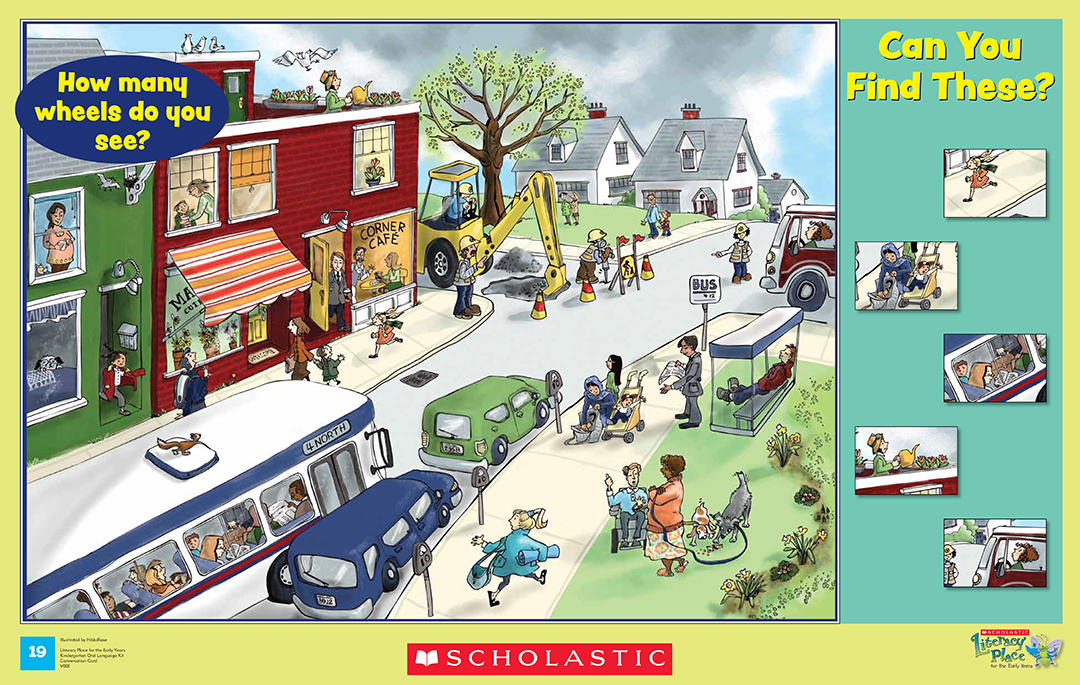Oral Language Teaching Strategy:
Connect With the Student’s Message Listen and respond to the meaning behind the student’s communication.
Time: one 30-minute or two 15-minute lessons
Materials: I-Spy Card #19
Grouping: whole class or small group
Assessment: Kindergarten Oral Language Assessment Scale
FOCUSING ON THE PICTURE
Teaching Tip: Before introducing this card, you may find it helpful to review the seasons and the characteristics of each season so the class is prepared to discuss what season is shown on the card.
- Show students the card and give them time to really look closely at it. To deepen their observations ask:
- What do you see in the picture?
- What do you think is happening?
- What time of year do you think it is? Why do you think that?
- After students have had an opportunity to really look at the picture have them turn to the person they are sitting beside and invite each student to share their ideas with their partner.
- Provide time for partner discussion and then invite a few partners to share their thinking with the group. Remember to connect with the child’s response and clarify when necessary.
- Offer prompts to stimulate discussion:
- Who do you think the people in this picture are?
- What are they doing?
- Where do you think they are?
- Do you recognize any of the landmarks? Where have you seen these landmarks in your neighbourhood?
Let’s take a close look at the picture. Where do you think the bus will stop? Who will get on or off the bus? Why do you think that? If you wanted to buy a drink, where would you go? What time of day is it? What makes you think that?
What do you think is happening?- What clues can we use to figure out what is happening in this picture?
GOING DEEPER
[Inferring/evaluating]- As students give their ideas about the picture, offer prompts to deepen their observations and their connections to the picture by discussing a time when you played ‘I Spy’ as a child.
- This is an ‘I-Spy’ picture. Has anyone ever played ‘I Spy’?
- If we look at the side of the picture, it asks us if we can find these small pictures. As we look for these small pictures, it is important we give everyone a chance to find them. When you find what you are looking for, put your hands on top of your head and then I will know that you have found the small picture.
- Let’s try to find the first picture of the girl running.
I used to play ‘I Spy’ with my family on long car trips.
-
Can everyone see this blue oval? There’s a question inside the oval that asks how many wheels you see. Let’s count together. Where should we start? Svetlana, you said, “the girl.” Do you mean the girl with the green scarf? Let’s start there.
After finding all five pictures, show students the blue oval with the question inside.
You may conclude the lesson at this point and do the second part on the next day, or you may decide to continue and do Connecting and Predicting as part of the first lesson.
CONNECTING
Teaching Tip: If you decide to do Connecting and Predicting on the second day, begin your lesson by reviewing the picture with the students.
[Making connections]- Have students draw on their personal experiences to make connections to this picture by asking:
- What season does this picture take place in?
- What kinds of things do you do in spring?
-
What can you find in the picture that you like to do? How do you feel when spring arrives? What changes do you notice happening in the spring?
Have you done anything that is shown in this picture? (wait for a bus, go for a walk) - Does this picture look like your neighbourhood? Why or why not?
PREDICTING
[Predicting]- Focus on specific scenarios in the picture by asking what might happen next to this person.
- Ask students what changes they might see if the picture showed a scene later in the day.
-
What changes would you see if this picture showed a summer scene? What would you take out of the picture? What would you add to the picture? Why?
Discuss what changes might occur in the picture if the picture showed a summer scene. Focus on what happens when spring changes to summer by asking what would change in the picture.
LESSON EXTENSIONS
-
Use the picture as a basis for a shared writing lesson. Begin by focusing on a specific scenario in the picture and discussing what might happen next. After collecting ideas from the students create two to three sentences together.
-
Divide chart paper into four and post the picture in the top left corner. Then add labels to the empty squares to show what seasons come next. Under each label brainstorm with students what kinds of things happen in each season.
FOLLOW-UP IN CENTRES
-
As a class, plant seeds so students can observe them as they grow. Have students keep a journal to draw and make notes showing the different stages of growth over a two-week period. This experience can be the basis for a shared reading lesson.
-
Provide a collection of ‘I Spy’ books at the reading centre for students to explore.
-
At the art centre have students create their own ‘I-Spy’ pictures of their neighbourhoods in the spring. Have students share their drawing with you or another student.
-
At the drama centre have students use animal puppets to role-play what each animal does in the spring.

